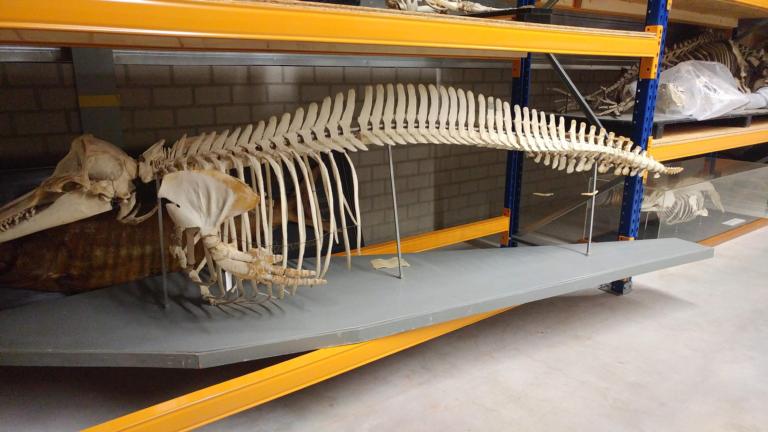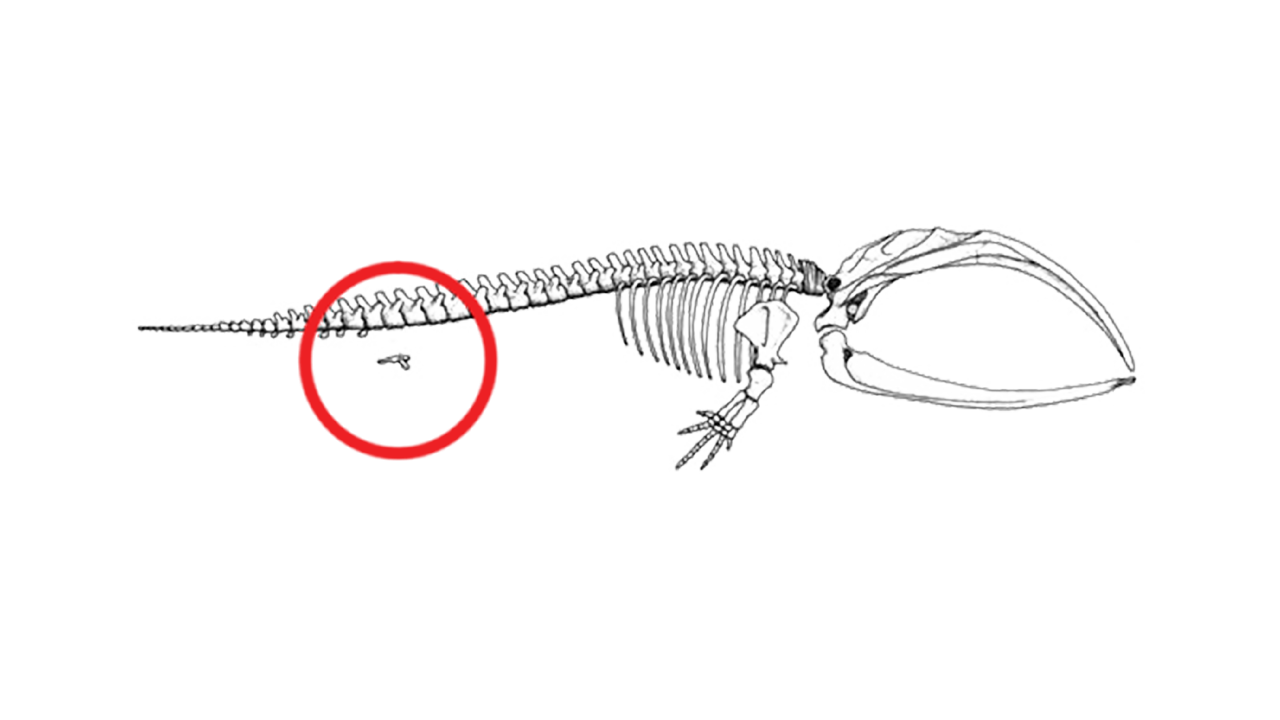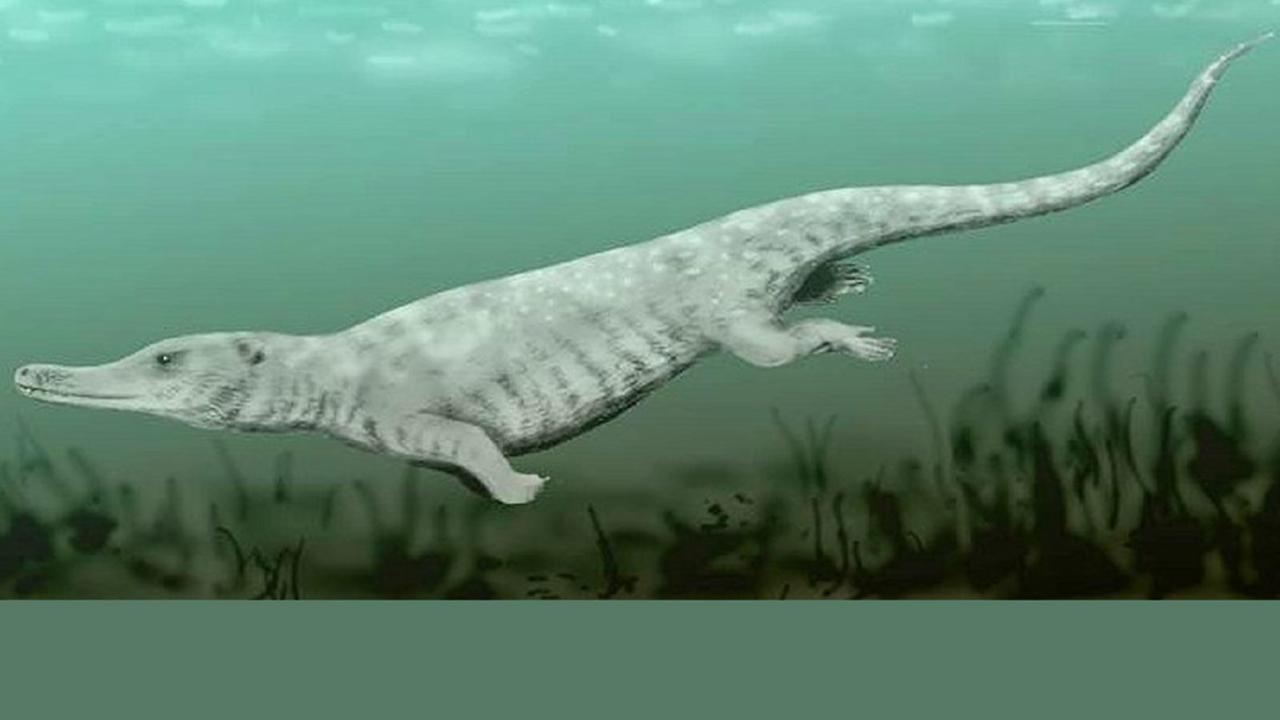
Whenever the whale team goes to a work on a specimen recently washed up, we know we have a rather disgusting challenge in front of us. One of the trickiest things when removing the many pounds of flesh is to be careful not to lose the tiny pelvic bones.
These two bones are embedded in the flesh around the genital area and because they are relatively small and not attached to the larger skeletal system. The pelvic bones are slightly curved and nearly symmetrical, with one on the left side of the body and one on the right. They vary in size and shape between species. Sometimes they can be nearly impossible to find. In fact, when you look at mounted whale skeletons in any museum, sometimes they might have only one pelvic bone, and sometimes they don’t have any! This means the whale cutter was unsuccessful in finding them during the preparation as all cetaceans have them.
Deze twee botten zitten ingebed in het vlees in de buurt van de geslachtsorganen onder de staart. De botjes zijn licht gebogen en bijna symmetrisch; met één aan de linkerkant van het lichaam en één aan de rechterkant. Ze variëren in grootte en vorm tussen soorten. Omdat ze relatief klein zijn en niet vastzitten aan het grotere skelet, zijn ze soms bijna onmogelijk te vinden. Let maar op: als je in musea naar walvisskeletten kijkt, zijn de bekkenbotten daarom vaak niet tentoongesteld (of maar ééntje)! Dit betekent dat de walvisontleder gefaald heeft in het opsporen van de botjes.
The pelvic bones are the small bones underneath the tailvertebrae. A close up of the bones is shown underneath the skeleton.
Illustration by Andrew Z. Colvin CC BY 3.0

For many years scientists believed that they were remnants of hind legs. Cetaceans are descended from Indohyus, a terrestrial animal with four legs. Though it probably resembled something like a small deer, researchers believe that it fed like a hippopotamus, an aquatic grazer. This changed about 40 million years ago, when Indohyus became an aquatic dweller, and later became the whales and dolphins we see swimming in our oceans today. Researchers believed that in a few million years, because of lack of use, maybe whales and dolphins would lose these bones entirely.
The Remingtonocetus. This extinct precessor of the cetaceae lived about 45 million years ago.
Illustration by Nobu Tamura CC BY 3.0

Research from 2014 found a very different explanation for these bones. That is, pelvic bones aren’t remnants, but instead an important part of cetacean reproduction. Attached to the pelvic bones are muscles which control the movement of the penis. Whales and dolphins mate in water, which can be challenging, so the ability to control the penis is important.
The researchers studied the pelvic bones of 130 individuals from 29 species in museum collections. Within the sample there was lots of variation in the size and shape of pelvic bones. Larger and more curved pelvic bones meant larger genitalia, however, large pelvic bones did not necessarily mean a larger animal. Promiscuous species have the largest pelvic bones, for example, the La Plata dolphin (Pontoporia blainvillei), a species of monogamous river dolphin, had the smallest pelvic bone. The largest was found in the Right Whale (Eubalaena glacialis), a species in which the females mate with multiple males, sometimes at the same time. In these situations, a male with pelvic bones able to support a larger more dextrous penis would have the most success.
These dolphins are trying to interact in some under water copulation.
Illustration by Ecohotel CC BY 3.0

Females have pelvic bones as well, but it is unclear what their purpose is. Perhaps some degree of movement of the vagina is required for underwater copulation. Or it could be a side effect of sexual selection in males.
There could be more secrets waiting to be unlocked regarding whale pelvic bones, and other bones as well. This is one of the reasons why we keep so many whales at the museum, so useful data sets can be created. And it is also the reason why when working on a freshly dead whale we proceed with care to record every bit of data, and save every bone, no matter how challenging the job is!